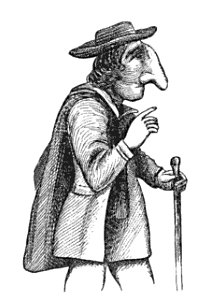
“The scientist does not study nature because it is useful; he studies it because it pleases him, and it pleases him because it is beautiful. Were nature not beautiful, it would not be worth knowing, life would not be worth living.” — Henri Poincaré

“The scientist does not study nature because it is useful; he studies it because it pleases him, and it pleases him because it is beautiful. Were nature not beautiful, it would not be worth knowing, life would not be worth living.” — Henri Poincaré

An ant will always position itself so that it’s precisely twice as far from vinegar as from honey. If we put a dab of vinegar at A and a dab of honey at B and we release a troop of ants, what formation will they take up?
Useful German:
The contraceptive pill is the Antibabypille. “I can understand German as well as the maniac that invented it,” wrote Mark Twain, “but I talk it best through an interpreter.”
Full text of the opinion of Michigan appeals court judge J.H. Gillis in Denny v. Radar Industries Inc., 1970:
The appellant has attempted to distinguish the factual situation in this case from that in Renfroe v. Higgins Rack Coating and Manufacturing Co., Inc. (1969), 17 Mich.App. 259, 169 N.W.2d 326. He didn’t. We couldn’t. Affirmed. Costs to appellee.
“It is truly a model of brevity,” wrote an Arizona state court justice. “If more judicial opinions were like this one, lawyers and judges who have to read them would be much happier, and the forests would be much safer.”
Charles Ollier observed that GHOTI can be pronounced “fish”:
Melville Dewey, who devised the Dewey Decimal System, suggested that GHEAUGHTEIGHPTOUGH spells “potato”:
This sort of thing can get out of hand quickly. In his 1845 Plea for Phonotypy and Phonography, Alexander John Ellis offered SCHIESOURRHCE for “scissors,” GNUITHEIERRH for “neither,” PHAIGHPHEAWRAIBT for “favorite,” PSOURRPHUAKNTW for “servant,” and (fittingly) EOLOTTHOWGHRHOIGHUAY for “orthography.”
GHOTI might even be silent:
Other languages, it seems, have simply surrendered — the Klingon word for fish is ghotI.
One of the most marvelous feats of recent times was performed in August, 1897, at Sondrio, capital of the Valtellina district, in the northern part of Italy, by Signor Edoe, professor in the Institution di Lorenzo, who, on a wager, repeated from memory, and without making a single mistake, the whole of Dante’s immortal poem, ‘Divina Commedia,’ which consists of nearly one hundred cantos, an amount of matter about equal to the number of words contained in the New Testament. The feat occupied about twenty-four hours in its accomplishment, lasting from 6 p.m. on one day until 2 p.m. the following day. It was achieved in the presence of a committee of associate professors and literary men, who, at about midnight, divided into two parties, alternately sleeping and listening until the recitation was finished, the text being carefully followed by prompters during the whole time, all in order that there might be no question as to the genuineness of the performance. This feat was accomplished after a preparation that was comparatively short, considering the great length of the poem, and is perhaps the most wonderful exhibition of verbal recollection in recent times.
— Henry H. Fuller, The Art of Memory, 1898

The longest nose in history, 7.5 inches, belonged to Thomas Wedders, who was exhibited throughout Yorkshire in the 1770s.
In Anomalies and Curiosities of Medicine (1901), George Milbry Gould writes, “This man expired as he had lived, in a condition of mind best described as the most abject idiocy.”
“The accompanying illustration is taken from a reproduction of an old print and is supposed to be a true likeness of this unfortunate individual.”

In 1933, Harvard mathematician George Birkhoff quantified beauty. The basic idea, he said, is that M = O/C, where M is the “aesthetic measure,” O is order, and C is complexity. By elaborating this principle into specific formulas, he decided that the square is the most pleasing polygon and the major triad the most pleasing diatonic chord. Of eight vases he considered, a Ming jar ranked highest, with M = 0.80, and in poetry the opening of Coleridge’s “Kubla Khan” received an M rating of 0.83. The same principles can be applied to painting, sculpture, and architecture.
This kind of use of the formula leads at once to certain well known aesthetic maxims:
- Unify as far as possible without loss of variety (that is, diminish the complexity C without decrease of the order O).
- Achieve variety in so far as possible without loss of unity (that is, increase O without increase of C).
- This ‘unity in variety’ must be found in the several parts as well as in the whole (that is, the order and complexity of the parts enter into the order and complexity of the whole).
“Now it seems to me that the postulation of genius in any mystical sense is unnecessary,” he concluded. “The analytic phase appears as an inevitable part of aesthetic experience. The more extensive this experience is, the more definite becomes the analysis.”
hypnobate
n. a sleepwalker
In Fain v. Commonwealth, 78 Ky. 183, the defendant, a somnambulist, had gone to sleep in a public room in a hotel, and on being roughly awakened by a stranger, drew a pistol and killed him, imagining himself in danger. The court observed: ‘If the prisoner is and has been afflicted in the manner claimed and knew, as he no doubt did, his propensity to do acts of violence when aroused from sleep, he was guilty of a grave breach of social duty in going to sleep in the public room of a hotel with a deadly weapon on his person, and merits for that reckless disregard of the safety of others some degree of punishment, but we know of no law under which he can be punished. Our law only punishes for overt acts done by responsible moral agents. If the prisoner was unconscious when he killed the deceased, he cannot be punished for that act, and as the mere fact that he had the weapon on his person and went to sleep with it there did no injury to any one, he cannot be punished for that.’ Now, is a man who knows himself liable to violent attacks of insanity guilty of ‘a grave breach of social duty’ in not incarcerating himself in an insane asylum?
— Albany Law Journal, July 8, 1882